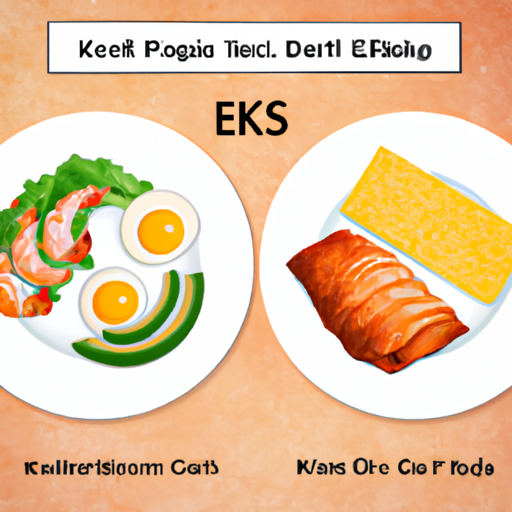Are you curious about the differences between the ketogenic diet and the Atkins diet? Well, you’ve come to the right place! In this article, we will delve into the key distinctions between these two popular low-carb diets. Whether you’re looking to lose weight or improve your overall health, understanding these differences can help you make an informed decision about which approach might be best for you.
Stay tuned to discover the unique characteristics of both the ketogenic and Atkins diets. We’ll explore the variations in macronutrient ratios, restrictions on certain food groups, and potential health benefits. By the end of this article, you’ll have a clearer understanding of the differences between these two diets and be one step closer to achieving your health and wellness goals. So, let’s get started and uncover the secrets of the ketogenic and Atkins diets together!
Ketogenic Diet
Definition and Basics
The ketogenic diet, commonly referred to as the keto diet, is a low-carbohydrate, high-fat diet that has gained considerable popularity in recent years. The basic principle of the ketogenic diet is to drastically reduce carbohydrate intake and replace it with fat. By doing so, the body enters a metabolic state called ketosis, where it begins to burn fat for fuel instead of carbohydrates.
Benefits of the Ketogenic Diet
The ketogenic diet offers several benefits for those who follow it. One of the primary benefits is weight loss. The high fat content of the diet keeps you fuller for longer and reduces cravings, making it easier to adhere to a calorie deficit. Additionally, the ketogenic diet has shown promising results in controlling blood sugar levels, improving insulin sensitivity, and managing type 2 diabetes. It has also been linked to improved mental focus and energy levels.
How Does the Ketogenic Diet Work?
The ketogenic diet works by drastically reducing the intake of carbohydrates, typically to less than 50 grams per day. This depletion of carbs forces the body to enter a state of ketosis, where it starts utilizing stored fat as its primary source of fuel. In the absence of carbohydrates, the liver converts fat into ketones, which are then used by the body and brain for energy. This shift in energy source is what leads to the numerous benefits associated with the ketogenic diet.
Types of Foods Allowed on the Ketogenic Diet
The foods allowed on the ketogenic diet primarily consist of low-carbohydrate, high-fat options. Some examples of foods you can enjoy on the ketogenic diet include meats, fish, eggs, avocados, vegetables, full-fat dairy products, nuts, and healthy oils like olive oil and coconut oil. It is essential to limit or avoid foods high in carbohydrates, such as grains, sugar, fruits, starchy vegetables, and processed foods.
Sample Ketogenic Diet Meal Plan
To give you an idea of what a typical day on the ketogenic diet might look like, here is a sample meal plan:
- Breakfast: Scrambled eggs cooked in butter with spinach and cheese.
- Snack: A handful of almonds.
- Lunch: Grilled chicken breast with a side of mixed greens drizzled with olive oil and vinegar.
- Snack: Celery sticks dipped in almond butter.
- Dinner: Baked salmon with roasted asparagus and cauliflower mash.
- Dessert: Full-fat Greek yogurt topped with a few berries.
Now that we’ve covered the basics of the ketogenic diet, let’s delve into how it differs from the Atkins diet.

Atkins Diet
Definition and Basics
The Atkins diet is another low-carbohydrate diet that focuses on weight loss and overall health. It was developed by Dr. Robert Atkins in the 1970s and has been popular ever since. Similar to the ketogenic diet, the Atkins diet also aims to shift the body into a state of ketosis by restricting carbohydrate intake.
Benefits of the Atkins Diet
Like the ketogenic diet, the Atkins diet offers numerous benefits. It has been shown to promote weight loss, improve blood sugar control, and reduce risk factors for heart disease. Additionally, it has been associated with increased satiety and reduced cravings, making it easier to adhere to for many individuals.
How Does the Atkins Diet Work?
The Atkins diet works by limiting carbohydrate intake, which causes the body to burn fat for fuel instead of carbohydrates. There are four phases to the Atkins diet, each with different carbohydrate restrictions and food choices. The initial phase, known as the Atkins induction phase, is the most restrictive and aims to initiate ketosis quickly. As the diet progresses, participants gradually increase their carbohydrate intake but still maintain a lower overall level compared to a typical diet.
Types of Foods Allowed on the Atkins Diet
The foods allowed on the Atkins diet vary depending on the phase. The induction phase strictly limits carbohydrates, allowing mainly high-protein foods like meat, fish, eggs, and non-starchy vegetables. As the diet progresses, participants can gradually reintroduce carbohydrates from sources like fruits, whole grains, and legumes. However, highly processed foods and added sugars are still discouraged.
Sample Atkins Diet Meal Plan
To provide you with an idea of what a day on the Atkins diet might look like, here is a sample meal plan:
- Breakfast: Omelet made with eggs, spinach, mushrooms, and cheese.
- Snack: Celery sticks with cream cheese.
- Lunch: Grilled chicken breast with a side of steamed broccoli and a small portion of quinoa.
- Snack: Hard-boiled eggs.
- Dinner: Baked cod with roasted Brussels sprouts and a side salad.
- Dessert: Sugar-free Jello with whipped cream.

Points of Difference
Now that we have discussed the ketogenic diet and the Atkins diet individually, let’s explore how they differ in several key areas:
Principle Focus
The principle focus of the ketogenic diet is to enter and maintain a state of ketosis, where the body primarily relies on fat for energy. On the other hand, the Atkins diet focuses on carbohydrate restriction and gradual reintroduction to achieve weight loss and improve overall health.
Macronutrient Composition
The macronutrient composition of the ketogenic diet typically includes 75% fat, 20% protein, and 5% carbohydrates. In contrast, the Atkins diet allows for a more gradual increase in carbohydrate intake and offers flexibility in adjusting macronutrient ratios based on individual needs and goals.
Carbohydrate Intake
The ketogenic diet severely limits carbohydrate intake to less than 50 grams per day, excluding most fruits and starchy vegetables. In the Atkins diet, carbohydrate intake varies depending on the phase, with the induction phase allowing only 20 grams of carbohydrates per day.
Fat Intake
Both diets emphasize the consumption of fats, but the ketogenic diet places a higher emphasis on healthy fats, such as avocados, nuts, and olive oil. The Atkins diet also encourages the consumption of healthy fats but allows for more flexibility in incorporating saturated fats.
Protein Intake
Protein intake on the ketogenic diet is moderate, with around 20% of total calories coming from protein sources. In contrast, the Atkins diet allows for a higher protein intake, especially during the early phases, to support muscle preservation and satiety.
Ketosis and Atkins Induction Phase
Both diets aim to induce ketosis; however, the ketogenic diet achieves this state more rapidly due to its stricter carbohydrate restrictions. The Atkins diet achieves ketosis during its induction phase, which is the most restrictive phase of the diet.
Long-Term Sustainability
The ketogenic diet can be challenging to sustain long-term due to its strict carbohydrate limitations and the potential for nutrient deficiencies if not properly planned. On the other hand, the Atkins diet offers more flexibility in carbohydrate intake throughout its various phases, making it potentially easier to sustain over a more extended period.
Health Effects and Risks
While both diets have shown numerous health benefits, it is essential to note that individual responses may vary. The ketogenic diet has been studied extensively for its potential in weight loss, blood sugar control, and epilepsy management. The Atkins diet has also shown promise in weight loss and blood sugar control but is also associated with concerns related to higher saturated fat intake.
Examples of Success Stories
Numerous success stories can be found for both diets, with individuals reporting significant weight loss, improved energy levels, and better overall health. However, it is essential to remember that individual results can vary, and consulting a healthcare professional or registered dietitian is advisable before starting any new diet plan.
Scientific Studies and Research
Both the ketogenic diet and the Atkins diet have been subjects of scientific studies and research. These studies have explored various aspects of each diet, including their impact on weight loss, blood sugar control, and adherence. While more research is still needed to fully understand the long-term effects and potential risks associated with these diets, the existing studies provide valuable insights into their efficacy and safety.

Conclusion
In conclusion, while the ketogenic diet and the Atkins diet share similarities in their low-carbohydrate approach and aim to induce ketosis, there are key differences between them. The ketogenic diet focuses primarily on maintaining a state of ketosis through strict carbohydrate restriction and emphasizes a specific macronutrient composition. On the other hand, the Atkins diet allows for a more gradual increase in carbohydrates and provides flexibility in adjusting macronutrient ratios. As with any diet, it is important to consult a healthcare professional or registered dietitian before embarking on either the ketogenic or Atkins diet to ensure it aligns with your individual goals and health needs.

